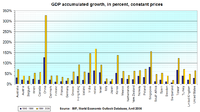
Photo from wikipedia
In this paper we decompose the change of the aggregate tax burden on labor in Austria. Our approach allows us to identify the impact of parametric changes in the tax… Click to show full abstract
In this paper we decompose the change of the aggregate tax burden on labor in Austria. Our approach allows us to identify the impact of parametric changes in the tax and social security system, of base broadening measures, and of changes in the wage structure. The aggregate implicit tax rate increased by more than 10pp since the mid-1970s. Most of it can be attributed to changes in payroll taxes and social security contributions payable by employers and employees. The increase in the implicit tax rate was also driven by base-broadening measures affecting the income tax and slightly dampened by changes in the wage income structure, most importantly the very weak growth in average wages since the 1990s. Moreover, while the contribution of changes in the income tax parameters to the increase in the aggregate implicit tax rate has been small, they were an important factor for the non-uniform development of the tax burden within the income structure. Excluding base broadening measures, the 95th percentile earner now faced a 13pp higher total burden in 2016 compared to 1975, while the increase for the 20th percentile earner was comparably modest (+ 2pp).
Journal Title: Empirica
Year Published: 2020
Link to full text (if available)
Share on Social Media: Sign Up to like & get
recommendations!